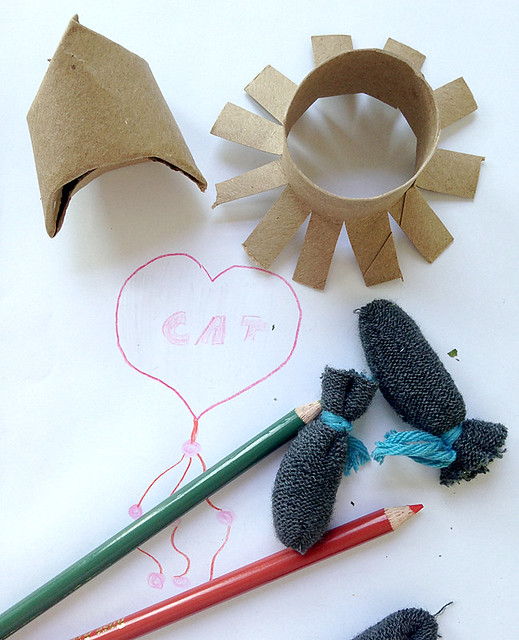Let’s Play: Helping Your Local Animal Shelter Through Creative-Free Play
Play and Community Service

Adopting, fostering, and pet taxing are a few ways families can help local animal shelters. Making toys for animals while waiting to be adopted is yet another way to support shelters while encouraging creative-free play at home. This month in “What to Play: Play Ideas for Family & Community,” Carrie shares several DIY projects families can do together to support our furry friends and the agencies that care for them.
It is the beginning of kitten season at the local animal shelters. From spring into summer the shelters are inundated with kittens! They are dropped off in boxes left at entrances overnight. Many are brought in because families are overcome with the work and dedication needed to take care of a litter of tiny babies. Some arrive with their mother or when a soon to deliver mother is surrendered. The main cause is lack of spaying. Many are so small they are not healthy or strong enough to be adopted out. Those tiny ones might spend time in a kitten ICU or go to live with caring foster families while they gain strength and put on weight.
This year we are not able to foster. We are missing the experience. The tiny kittens have so much love, cuddles and silly play to share. It is a great experience to watch them grow, to teach them to eat solids and even to figure out the best way to provide needed medications. Kittens do not like medications. We failed as fosters last year by adopting a “tuxedo” from the last batch of siblings we had in May. Many foster families fail and joke about this. We get attached to the tiny ones and adopt. Our two furry boys have taken over so we no longer have the spare room to devote to fosters. Adopting from our last foster group was a bonus for our family in many ways. My daughter has the lap cat she has been hoping to have for years. They are inseparable. He cries in her room when she has a sleepover or play date and does not come home at the end of the day. He watches her brush her teeth. She has trained him to use a leash and play fetch. A perfect match. I have to say it is nice to have him in our family. Oh, and he has a safe home to call his own forever and a big orange brother to sleep with.
One day we will foster again. We want to help those tiny babies get a great start on life.
Instead, we drive a pet taxi two weekends each month. We load up the car with cats, kittens, dogs, bunnies, hamsters, etc. to transport them to other facilities. It is fun. The car can get loud if we have a howling dog in the back and a singing cat in the front. My daughter spends the drive renaming everyone after her favorite book characters. Never a dull ride. No mention of “Are we there, yet?”
I have been missing the tiny fosters, so we loaded up the kitchen table with a pile of those saved tp and paper towel rolls from the recycling. I found a few single knit gloves from winter and my daughter brought out her stack of paper and colored pencils with piles fabric scraps. We are making cat toys to donate to the shelter. Each paper tube can be cut in half to make 2 toys. One just for chasing and pouncing (sunshine toy, below). The other to fill with cat treats (treat rattle, below). The fingers can be cut off knit gloves, filled with catnip and securely tied off to make little soft toys. The designer in your house can draw up simple toys and sew them together for more catnip fun. I have provided a few links for ideas. Family members of all ages can stuff catnip while older kids do the cutting and sewing. The family can work together on a service project while playing with ideas & materials and having fun.
Call your local shelter and see what things they are looking for. Some might need toys for dog enrichment or care. Some might only be looking for cat items. Some might need apple twigs bundled from small animals to nibble. Last winter my mother and I sewed up a large stack of doggie diapers. Many shelters are also in need of very simple projects such as sheets cut into quarters that are used to provide hiding places for timid felines. Many project possibilities for many ages.
- DIY Cat Toys: www.catster.com
- DIY Cardboard Ball: www.instructables.com
- DIY Cardboard Mouse: www.instructables.com
- DIY Catnip Toy: makeovermeow.wordpress.com
ABOUT THE AUTHOR
Carrie was born, raised and attended university in Michigan. As a child she rode bikes and explored her rural neighborhood freely with siblings and neighbor kids. Mom and Dad never worried. The kids always made it home after hours wading in the creek and climbing trees in the woods. After college she moved to Kyoto, Japan to study traditional Japanese woodblock printing. In 1995, she began a career at a small Chicago firm designing maps and information graphics. Life brought a move to Northampton in 2001. Carrie completed her MFA at UMass in 2004. Her little love, Sophia, was born in 2005. The two live in downtown Northampton where they constantly make things, look forward to morning walks to school and plan each spring for additions to their plot at the community garden. Carrie continues to do freelance work for clients here and in Chicago.
 Hilltown Families
Hilltown Families 






























